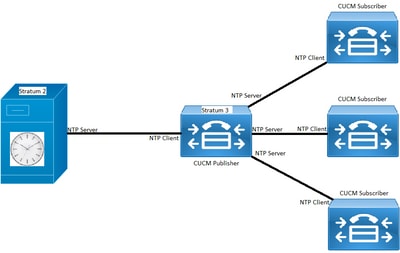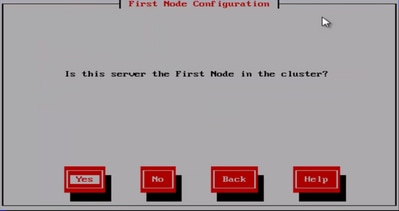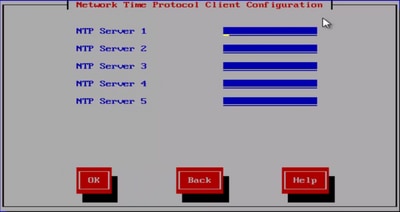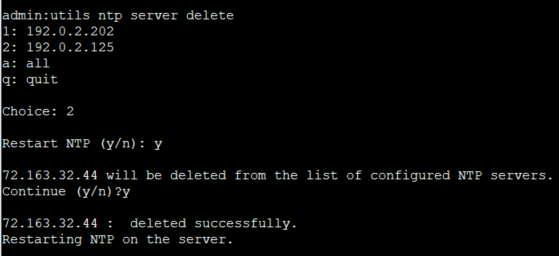Configurar y solucionar problemas de NTP en CUCM y IM&P
Opciones de descarga
-
ePub (525.0 KB)
Visualice en diferentes aplicaciones en iPhone, iPad, Android, Sony Reader o Windows Phone -
Mobi (Kindle) (439.5 KB)
Visualice en dispositivo Kindle o aplicación Kindle en múltiples dispositivos
Lenguaje no discriminatorio
El conjunto de documentos para este producto aspira al uso de un lenguaje no discriminatorio. A los fines de esta documentación, "no discriminatorio" se refiere al lenguaje que no implica discriminación por motivos de edad, discapacidad, género, identidad de raza, identidad étnica, orientación sexual, nivel socioeconómico e interseccionalidad. Puede haber excepciones en la documentación debido al lenguaje que se encuentra ya en las interfaces de usuario del software del producto, el lenguaje utilizado en función de la documentación de la RFP o el lenguaje utilizado por un producto de terceros al que se hace referencia. Obtenga más información sobre cómo Cisco utiliza el lenguaje inclusivo.
Acerca de esta traducción
Cisco ha traducido este documento combinando la traducción automática y los recursos humanos a fin de ofrecer a nuestros usuarios en todo el mundo contenido en su propio idioma. Tenga en cuenta que incluso la mejor traducción automática podría no ser tan precisa como la proporcionada por un traductor profesional. Cisco Systems, Inc. no asume ninguna responsabilidad por la precisión de estas traducciones y recomienda remitirse siempre al documento original escrito en inglés (insertar vínculo URL).
Contenido
Introducción
Este documento describe el protocolo de tiempo de red (NTP) para Cisco Unified Communications Manager (CUCM).
Prerequisites
Requirements
No hay requisitos específicos para este documento.
Componentes Utilizados
Este documento no tiene restricciones específicas en cuanto a versiones de software y de hardware.
La información que contiene este documento se creó a partir de los dispositivos en un ambiente de laboratorio específico. Todos los dispositivos que se utilizan en este documento se pusieron en funcionamiento con una configuración verificada (predeterminada). Si tiene una red en vivo, asegúrese de entender el posible impacto de cualquier comando.
Objetivo de la función
Este documento cubre el propósito de NTP con CUCM, la configuración de NTP, qué datos recopilar para resolver problemas, un análisis de ejemplo de los datos y los recursos relacionados para una investigación adicional.
El propósito del NTP con CUCM es garantizar que los servidores conocen la hora correcta. El tiempo en los servidores de CUCM es importante porque el protocolo de voz sobre Internet (VOIP) es extremadamente sensible a las variaciones de tiempo.
El clúster de CUCM debe mantener una sincronización horaria que permanezca cerca de los otros servidores del clúster, debido a los requisitos de replicación de la base de datos.
Por último, el tiempo para solucionar problemas es importante ya que desea tener las marcas de tiempo correctas en los registros.
Configurar

Nota: CUCM requiere determinados servidores NTP.
El servidor NTP de Windows no es compatible con CUCM; sin embargo, se aceptan otros tipos, como fuentes NTP de Linux, fuentes NTP de Cisco IOS® y fuentes NTP de Nexus OS.
Aunque otras soluciones de Cisco pueden utilizar servidores Windows para la solución NTP, las soluciones de UC como Call Manager, Cisco Unity y Instant Messaging and Presence no pueden hacerlo y requieren una solución NTP basada en Linux o en Cisco IOS®.
Esto se debe a que Windows Time Services a menudo utiliza SNTP con el que los sistemas Linux tienen dificultades para sincronizar.
Diagrama de la red
El editor de CUCM necesita un origen NTP que no sea miembro del clúster de CUCM; por lo tanto, el editor de CUCM sincroniza su tiempo con el servidor NTP. En este intercambio, el editor de CUCM es un cliente NTP.
Los suscriptores de CUCM sincronizan su tiempo con el editor de CUCM. En este intercambio, el editor de CUCM es un servidor NTP donde los suscriptores de CUCM son clientes NTP.
Precaución: tenga en cuenta que los servidores de mensajería instantánea y presencia (IM&P) de Cisco también se consideran suscriptores del clúster de CUCM, por lo que también dependen del NTP de CUCM. En otras palabras, si el NTP no está sincronizado en el servidor IM&P, causa problemas en el sistema con la replicación de la base de datos y la alta disponibilidad.

Proceso de instalación
Cuando se instala CUCM, se muestra un mensaje para determinar si el servidor es el primer nodo del clúster.

Si el servidor no es el primer nodo del clúster, el asistente de instalación pasa la fase de configuración de NTP; sin embargo, se le solicitarán los servidores NTP si son el primer nodo del clúster.

Después de la instalación, utilice la página web de administración del sistema operativo

Después de la instalación, utilice la interfaz de línea de comandos
Como se muestra en las imágenes, puede encontrar los comandos utilizados para acceder y modificar los servidores NTP dentro del servidor CUCM.
- El comando utils ntp server list muestra los servidores NTP configurados en su sistema.

- El comando utils ntp server add ntp_address agrega un nuevo servidor NTP al sistema.

Nota: Tenga en cuenta que si desea agregar un nuevo servidor NTP, el servidor de CUCM comprueba la disponibilidad antes de agregarlo; si falla, aparece el siguiente error.

- El comando utils ntp server delete permite eliminar cualquiera de los NTP ya configurados en el sistema.

Troubleshoot
Datos que recopilar
Cuando resuelve un problema de NTP, se le solicita que recopile estos datos de cualquier servidor de CUCM que tenga los problemas de NTP:
- El resultado del comando utils diagnose prueba.
- El resultado del comando utiliza el estado ntp.
- Los registros de NTP de CUCM recopilados de la herramienta Cisco Real-Time Monitor Tool (RTMT).
Análisis de ejemplo
Por ejemplo, se ha utilizado la siguiente información del publicador de CUCM y NTP:
Publicador de CUCM
Versión: 11.5(1) SU5
FQDN: cucm-115.home.lab
La dirección IP comienza por 192.X.X.X
NTP
Desde el servidor NTP de Google
FQDN: time1.example.com.ntp
La dirección IP comienza por 216.X.X.X
Revisión de PCAP para CUCM: sin archivo
Observe que el número de puerto es 123. Este es el puerto para NTP. En la salida del comando en el cuadro de texto, puede ver que la versión de NTP es 4, como lo indica NTPv4. También puede tomar nota del editor, que actúa como cliente cuando establece su comunicación con time1.example.com; sin embargo, funciona como servidor cuando establece comunicación con cucm-sub1, cucm-sub2 y cucm-sub3.
From the CLI of the publisher run the command "utils network capture port 123" Wait until you see traffic (this can take a little time, or it may be instant) then hit
ctrl+c. Look in the traffic to find where your publisher is communicating with its NTP
server and the NTP server is communication with the publisher (if the NTP server isn't
replying then it is an issue in the network or with the NTP server). The primary focus of
this output is the NTP version. In CUCM 9 and later NTP version 3 (NTPv3) can cause issues
and an NTP source using NTPv4 should be the NTP server for the publisher.
admin:utils network capture size all count 10000000 port 123 Executing command with options: size=128 count=1000 interface=eth0 src=dest= port=123 ip= 16:08:43.199710 IP cucm-sub3.home.lab.39417 > cucm-115.home.lab.ntp: NTPv4, Client, length 48 16:08:43.199737 IP cucm-115.home.lab.ntp > cucm-sub3.home.lab.39417: NTPv4, Server, length 48 16:08:43.199823 IP cucm-sub3.home.lab.39417 > cucm-115.home.lab.ntp: NTPv4, Client, length 48 16:08:43.199859 IP cucm-115.home.lab.ntp > cucm-sub3.home.lab.39417: NTPv4, Server, length 48 16:09:01.640980 IP cucm-115.home.lab.50141 > time1.example.com.ntp: NTPv4, Client, length 48 16:09:01.654675 IP time1.example.com.ntp > cucm-115.home.lab.50141: NTPv4, Server, length 48 16:09:01.654733 IP cucm-115.home.lab.50141 > time1.example.com.ntp: NTPv4, Client, length 48 16:09:01.667368 IP time1.example.com.ntp > cucm-115.home.lab.50141: NTPv4, Server, length 48 16:09:01.668612 IP cucm-115.home.lab.50141 > time1.example.com.ntp: NTPv4, Client, length 48 16:09:01.681366 IP time1.example.com.ntp > cucm-115.home.lab.50141: NTPv4, Server, length 48 16:09:01.681518 IP cucm-115.home.lab.50141 > time1.google.com.ntp: NTPv4, Client, length 48 16:09:01.694108 IP time1.google.com.ntp > cucm-115.home.lab.50141: NTPv4, Server, length 48 16:09:01.875016 IP cucm-115.home.lab.48422 > time1.google.com.ntp: NTPv4, Client, length 48 16:09:01.884476 IP cucm-sub3.home.lab.58072 > cucm-115.home.lab.ntp: NTPv4, Client, length 48 16:09:01.884568 IP cucm-115.home.lab.ntp > cucm-sub3.home.lab.58072: NTPv4, Server, length 48 16:09:01.884954 IP cucm-sub3.home.lab.58072 > cucm-115.home.lab.ntp: NTPv4, Client, length 48 16:09:01.884999 IP cucm-115.home.lab.ntp > cucm-sub3.home.lab.58072: NTPv4, Server, length 48 16:09:01.885381 IP cucm-sub3.home.lab.58072 > cucm-115.home.lab.ntp: NTPv4, Client, length 48 16:09:01.885423 IP cucm-115.home.lab.ntp > cucm-sub3.home.lab.58072: NTPv4, Server, length 48 16:09:01.886147 IP cucm-sub3.home.lab.58072 > cucm-115.home.lab.ntp: NTPv4, Client, length 48 16:09:01.886184 IP cucm-115.home.lab.ntp > cucm-sub3.home.lab.58072: NTPv4, Server, length 48 16:09:01.888555 IP time1.google.com.ntp > cucm-115.home.lab.48422: NTPv4, Server, length 48 16:09:01.888642 IP cucm-115.home.lab.48422 > time1.google.com.ntp: NTPv4, Client, length 48 16:09:01.900926 IP time1.google.com.ntp > cucm-115.home.lab.48422: NTPv4, Server, length 48 16:09:01.901017 IP cucm-115.home.lab.48422 > time1.google.com.ntp: NTPv4, Client, length 48 16:09:01.913497 IP time1.google.com.ntp > cucm-115.home.lab.48422: NTPv4, Server, length 48 16:09:01.913566 IP cucm-115.home.lab.48422 > time1.google.com.ntp: NTPv4, Client, length 48 16:09:01.926693 IP time1.google.com.ntp > cucm-115.home.lab.48422: NTPv4, Server, length 48 16:09:02.038981 IP cucm-sub2.home.lab.42078 > cucm-115.home.lab.ntp: NTPv4, Client, length 48 16:09:02.039117 IP cucm-115.home.lab.ntp > cucm-sub2.home.lab.42078: NTPv4, Server, length 48 16:09:02.039281 IP cucm-sub2.home.lab.42078 > cucm-115.home.lab.ntp: NTPv4, Client, length 48 16:09:02.039345 IP cucm-115.home.lab.ntp > cucm-sub2.home.lab.42078: NTPv4, Server, length 48 16:09:02.039434 IP cucm-sub2.home.lab.42078 > cucm-115.home.lab.ntp: NTPv4, Client, length 48 16:09:02.039535 IP cucm-115.home.lab.ntp > cucm-sub2.home.lab.42078: NTPv4, Server, length 48 16:09:02.039607 IP cucm-sub2.home.lab.42078 > cucm-115.home.lab.ntp: NTPv4, Client, length 48 16:09:02.039814 IP cucm-115.home.lab.ntp > cucm-sub2.home.lab.42078: NTPv4, Server, length 48 16:09:02.066544 IP cucm-sub1.home.lab.46400 > cucm-115.home.lab.ntp: NTPv4, Client, length 48 16:09:02.066622 IP cucm-115.home.lab.ntp > cucm-sub1.home.lab.46400: NTPv4, Server, length 48 16:09:02.066751 IP cucm-sub1.home.lab.46400 > cucm-115.home.lab.ntp: NTPv4, Client, length 48 16:09:02.066892 IP cucm-115.home.lab.ntp > cucm-sub1.home.lab.46400: NTPv4, Server, length 48 16:09:02.066968 IP cucm-sub1.home.lab.46400 > cucm-115.home.lab.ntp: NTPv4, Client, length 48 16:09:02.067104 IP cucm-115.home.lab.ntp > cucm-sub1.home.lab.46400: NTPv4, Server, length 48 16:09:02.067155 IP cucm-sub1.home.lab.46400 > cucm-115.home.lab.ntp: NTPv4, Client, length 48 16:09:02.067189 IP cucm-115.home.lab.ntp > cucm-sub1.home.lab.46400: NTPv4, Server, length 48
Revisión de PCAP para CUCM - Con archivo
El filtro utilizado para resolver el problema de NTP en la captura de paquetes es: udp.port == 123. Con ese filtro, se puede ver que el editor de CUCM estableció comunicación con el servidor de Google NTP y que el editor de CUCM también se comunicó con los suscriptores de CUCM.

Revisión de salida de CLI para CUCM
utils ntp status output
NOTE: All nodes will show the current time in UTC regardless of the time zone of the server
(listed in UTC time). This makes it easy to compare times on the different CUCM nodes.
NOTE: If there is a time difference of 15 minutes or more, it is expected that DB replication
will be broken
1) If the publisher is ahead by 15 minutes, this can result in the pub send data to the
sub and the sub would have a delay to process the data because it has not yet reached the time
in the timestamp of the packets from the publisher (this is expected behavior in this type of situation)
2) If the subscriber is ahead by 15 minutes, this would result in the subscriber drop
the data from the publisher because the subscriber sees it as old data (15 minutes old)
admin:utils ntp status
ntpd (pid 28435) is running...
remote refid st t when poll reach delay offset jitter
==============================================================================
203.0.113.0 .GOOG. 1 u 44 64 3 11.724 -0.021 0.064
unsynchronised
polling server every 8 s
Current time in UTC is : Fri Sep 6 20:54:50 UTC 2019
Current time in America/New_York is : Fri Sep 6 16:54:50 EDT 2019
admin:
Lea la siguiente información, ya que explica la salida anterior en detalle.
The very first column contains the "tally code" character. Short overview:
* the source you are synchronized to (syspeer)
# source selected, distance exceeds maximum value
o the PPS(Pulse Per Second) source if your ntpd (ppspeer, only if you have a PPS capable system and refclock)
+ candidate, i.e. it is considered a good source
- outlyer, i.e. quality is not good enough
x falseticker, i.e. this one is considered to distribute bad time
blank: source discarded, failed sanity
See the Select field of the Peer status word on the NTP Event Messages and
Status Words page for more information on the tally codes.
remote
the hostname or IP of the remote machine.
refid
the identification of the time source to which the remote machines is synced.
May be (for example) a radio clock or another ntp server)
st
the stratum of the remote machine. 16 is "unsynchronized". 0 is the best
value, that could be (for example) a radio clock or the ntp servers private
caesium clock (see http://www.eecis.udel.edu/~mills/ntp/html/index.html#intro
for more information about ntp in general).
t
types available:
l = local (such as a GPS, WWVB)
u = unicast (most common)
m = multicast
b = broadcast
- = netaddr
when
how many seconds since the last poll of the remote machine.
poll
the polling interval in seconds.
reach
an 8-bit left-rotating register. Any 1 bit means that a "time packet" was
received. The right most bit indicate the status of the last connection
with the NTP server. It is Octal number. Use calculator in progammer
interface to translate from OCT to BIN: For example 377 translates to
11111111. Each 1 means a successful connection to the NTP server. If you
just start a NTP service, and it connects successfully with its server, this
number will change as follows (if connectivity is good):
00000001 = 001
00000011 = 003
00000111 = 007
00001111 = 017
00011111 = 037
00111111 = 077
01111111 = 177
11111111 = 377
delay
the time delay (in milliseconds) to communicate with the remote.
offset
the offset (in milliseconds) between our time and that of the remote.
jitter
the observed jitter (in milliseconds) of time with the remote.
Resultados de la prueba de diagnóstico Utils
admin:utils diagnose test Log file: platform/log/diag1.log Starting diagnostic test(s) =========================== test - disk_space : Passed (available: 6463 MB, used: 12681 MB) skip - disk_files : This module must be run directly and off hours test - service_manager : Passed test - tomcat : Passed test - tomcat_deadlocks : Passed test - tomcat_keystore : Passed test - tomcat_connectors : Passed test - tomcat_threads : Passed test - tomcat_memory : Passed test - tomcat_sessions : Passed skip - tomcat_heapdump : This module must be run directly and off hours test - validate_network : Passed test - raid : Passed test - system_info : Passed (Collected system information in diagnostic log) test - ntp_reachability : Passed test - ntp_clock_drift : Passed test - ntp_stratum : Passed skip - sdl_fragmentation : This module must be run directly and off hours skip - sdi_fragmentation : This module must be run directly and off hours Diagnostics Completed The final output will be in Log file: platform/log/diag1.log Please use 'file view activelog platform/log/diag1.log' command to see the output admin:
Si NTP falla en el resultado de la prueba de diagnóstico de utilidades, verá algo similar a esto:
admin:utils diagnose test Log file: platform/log/diag1.log Starting diagnostic test(s) =========================== test - disk_space : Passed (available: 6463 MB, used: 12681 MB) skip - disk_files : This module must be run directly and off hours test - service_manager : Passed test - tomcat : Passed test - tomcat_deadlocks : Passed test - tomcat_keystore : Passed test - tomcat_connectors : Passed test - tomcat_threads : Passed test - tomcat_memory : Passed test - tomcat_sessions : Passed skip - tomcat_heapdump : This module must be run directly and off hours test - validate_network : Passed test - raid : Passed test - system_info : Passed (Collected system information in diagnostic log) test - ntp_reachability : Warning The NTP service is restarting, it can take about 5 minutes. test - ntp_clock_drift : Warning The local clock is not synchronised. None of the designated NTP servers are reachable/functioning or legitimate. test - ntp_stratum : Warning The local clock is not synchronised. None of the designated NTP servers are reachable/functioning or legitimate. skip - sdl_fragmentation : This module must be run directly and off hours
Confirme que el NTP era correcto en el momento de la instalación. Ejecute el comando:
run sql select pkid,name,dbinfo('utc_to_datetime', cdrtime) as CDRTIME from device where cdrtime > getCurrTime()
Este comando compara la hora actual con la hora cdrtime (cuando se modificó la tabla). Si utilizó un NTP incorrecto en la instalación/actualización y luego corrigió el NTP, la base de datos se desincroniza cada vez que se realiza un cambio. Este problema no se vería cuando ejecuta los comandos típicos de NTP (por ejemplo, utils ntp status) porque se ha alejado del origen de NTP incorrecto a uno bueno.
Sería bueno que se alejara del NTP malo a uno bueno; sin embargo, un movimiento a un buen origen NTP no arreglaría las tablas que se crearon durante la instalación/actualización.
Cuando ejecuta este comando, el resultado esperado es el siguiente:
admin:run sql select pkid,name,dbinfo('utc_to_datetime', cdrtime) as CDRTIME from device where cdrtime > getCurrTime()
pkid name cdrtime
==== ==== =======
admin:
Si tiene un resultado similar al siguiente, es una señal de que el NTP utilizado para la instalación/actualización no se ha utilizado y ha causado problemas que afectan a la replicación de la base de datos:
admin:run sql select pkid,name,dbinfo('utc_to_datetime', cdrtime) as CDRTIME from device where cdrtime > getCurrTime()
pkid name cdrtime
============================= ===== =====================
bf80dd31-9911-43ce-81fd-a99ec0333fb5 MTP_2 2016-09-11 14:38:14.0
4c38fc05-760d-4afb-96e8-69333c195e74 CFB_2 2016-09-11 14:38:14.0
90878c80-e213-4c7e-82b9-6c780aac72f3 ANN_2 2016-09-11 14:38:14.0
08b5bff4-da94-4dfb-88af-ea9ffa96872c MOH_2 2016-09-11 14:38:14.0
93320e4d-1b73-4099-9a7c-c4cddfadb5d9 MTP_3 2016-09-11 14:38:14.0
a6850d42-5f0a-49ce-9fa3-80d45b800e23 CFB_3 2016-09-11 14:38:14.0
9963c9cb-58b0-4191-93e1-8676584f6461 ANN_3 2016-09-11 14:38:14.0
def79fb7-c801-4fb3-85fb-4e94310bf0bd MOH_3 2016-09-11 14:38:14.0
4cd64584-089b-4331-9291-79774330cbc 2 MTP_4 2016-09-11 14:38:14.0
27b18882-db83-4d14-8bce-d3f8dc439610 CFB_4 2016-09-11 14:38:14.0
a40da882-e04f-4649-b2eb-2f79d1289e81 ANN_4 2016-09-11 14:38:14.0
36575ff4-cdea-4945-87e7-638cc555463e MOH_4 2016-09-11 14:38:14.0
Otras consideraciones
1) Si actualiza los hosts de ESXi sin tener en cuenta las consideraciones de hardware de VM, puede experimentar problemas de NTP.
2) Asegúrese de que la versión de ESXi cumple con la matriz de virtualización.
3) Asegúrese de que la versión de ESXi y la versión de hardware son compatibles.
Información Relacionada
- Soporte Técnico y Documentación - Cisco Systems
- Cisco Collaboration System 10.x Solution Reference Network Designs (SRND)
- Cambio del origen NTP en CUCM desde CLI y otra información útil
- Resolución de problemas de NTP en Cisco Unified Communications Manager
- Protocolo de tiempo de la red: informe técnico sobre prácticas recomendadas
- Captura de paquetes en el modelo de dispositivo CUCM
Historial de revisiones
| Revisión | Fecha de publicación | Comentarios |
|---|---|---|
4.0 |
22-Nov-2023 |
Actualización de Introducción, Texto alternativo y Formato para cumplir con las directrices actuales de Cisco. |
3.0 |
18-Oct-2022 |
PII potencial actualizado y optimización de motores de búsqueda. |
2.0 |
15-Mar-2022 |
Actualizaciones gramaticales. |
1.0 |
20-May-2020 |
Versión inicial |
Con la colaboración de ingenieros de Cisco
- Patrick KinaneCisco TAC Engineer
Contacte a Cisco
- Abrir un caso de soporte

- (Requiere un Cisco Service Contract)
 Comentarios
Comentarios